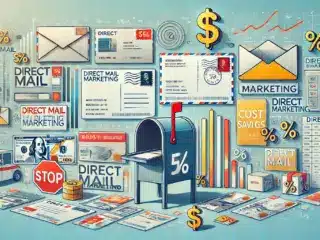Last Updated on September 1, 2025 by Carlos Alonso
Using AI to Personalize Direct Mail: Increasing ROI 4X Over Standard Campaigns
Direct mail isn’t what it used to be. We are way past the “Hey [First Name]” thing. Brands now use AI for direct mail personalization to pull off things that feel eerie in a good way. Timing is spot on. The message is freakishly relevant. And that is how ROI just multiplies.
Intrigued? We thought so, and that is why we put this guide together. We will show you how AI connects online behavior to offline outreach and how you can use it to create moments that feel too perfect to be a coincidence.
Why Is Direct Mail Still Effective For Brands & Consumers
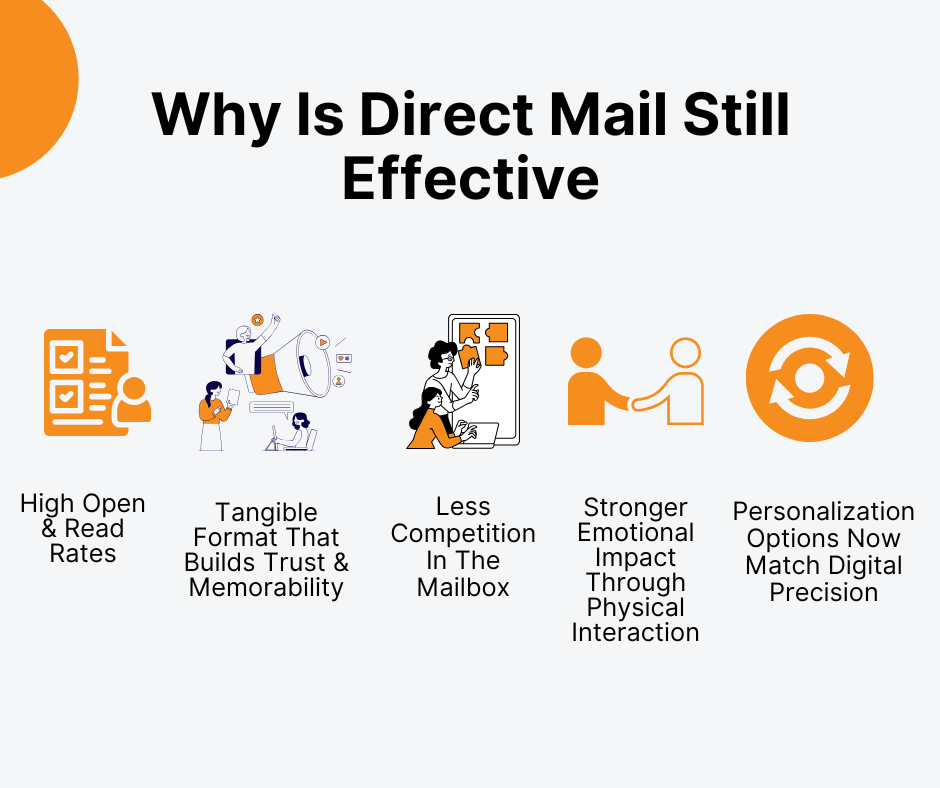
People keep predicting the “death” of direct mail, but it is quietly outperforming in places where digital marketing channels are hitting a wall. It is not nostalgia, and it is not about being “old-school.” Let’s break down why it is still a heavy hitter for both brands and consumers.
1. High Open & Read Rates Compared To Email Marketing
Most marketing emails are lucky to get opened by 20% of recipients. But around 90% of direct mail gets opened, and people actually read it. There is no spam folder for your mailbox, and most people at least glance at every piece of mail they get.
For brands, that is a massive visibility advantage. For consumers, it means they are not bombarded with hundreds of competing messages at once.
2. Tangible Format That Builds Trust & Memorability
Holding something gives it weight – literally and figuratively. A postcard or brochure feels more “real” than a pop-up ad. Studies show people trust printed material more, and they are 70% more likely to remember it longer than an online ad. That tangibility makes the brand feel established and worth paying attention to.
3. Less Competition In The Mailbox Means Higher Visibility
Email inboxes are overflowing. Social feeds are endless. Your physical mailbox has a handful of items a day. That scarcity works in your favor. Fewer competitors in the mailbox means your marketing content is seen and, more importantly, noticed.
4. Stronger Emotional Impact Through Physical Interaction
There is a sensory experience in opening an envelope or flipping through a catalog. The texture, the colors, even the smell of fresh print – it is a different kind of engagement that triggers stronger emotional and meaningful connections. When something feels personal and crafted, people are more likely to form a bond with the brand.
5. Personalization Options Now Match Digital Precision
This is where it gets exciting. With AI tools for direct mail personalization, brands can target as sharply as they do online. Names, purchase history, browsing behavior, even life events – these can all be used in direct mail marketing that is perfectly timed and highly relevant.
The result is a stronger response rate and ROI that can blow past standard direct mail marketing campaigns.
How AI Enhances Every Stage Of A Direct Mail Campaign
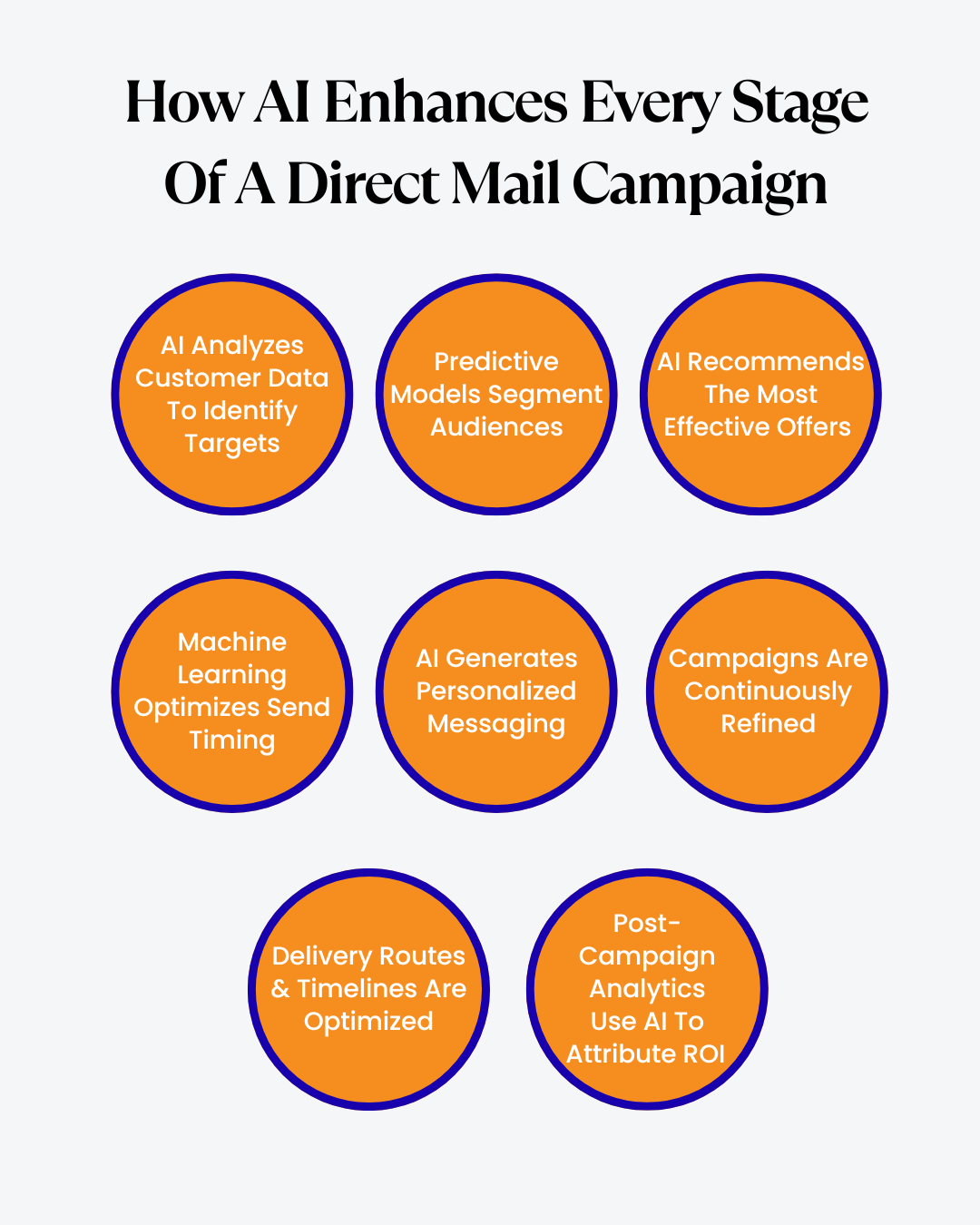
Artificial intelligence rewires the entire direct mail process. Instead of treating a campaign like one big blast to everyone on a list, AI turns it into a series of precise steps that make every piece of mail count. Here’s how AI in direct mail works at each stage.
1. AI Analyzes Customer Data To Identify High-Value Targets
Before any direct mail piece even hits a printer, AI is already at work going through massive amounts of historical data. We are talking purchase history, browsing patterns, loyalty program activity, email engagement, demographic details – basically, every digital breadcrumb someone leaves behind.
AI looks for deeper signals that separate casual customers from those who are likely to deliver serious, long-term value. For example, it can pick up on repeat purchase cycles or the kind of engagement that suggests a customer is about to move into a higher-spending bracket.
Instead of guessing who should be on your mailing list, AI integration helps pinpoint the exact people who are statistically most likely to spend and keep buying. That means your print budget isn’t wasted on people who barely remember your brand.
2. Predictive Models Segment Audiences Based On Behavior & Interests
Once the high-value targets are identified, predictive analytics sorts them into smaller, more accurate audience segments based on how they think and interact with your brand.
Behavior is a huge factor here. Someone who frequently engages with eco-friendly products isn’t going to react the same way as someone who always buys the latest tech. AI algorithms pick up on these patterns automatically and create segments that go far beyond basic age or location demographics.
It also factors in interests that might not be obvious at first glance. For instance, maybe a customer hasn’t directly bought running gear from you, but their browsing activity shows they have spent time looking at it. Predictive models notice those past interactions and group people accordingly, so you end up with more precise targeting from the start.
3. AI Recommends The Most Effective Offers For Each Customer Profile
Here’s where it gets interesting. It analyzes what each customer profile is most likely to respond to, then recommends the exact offers that will get the best reaction.
This isn’t just “send a discount to everyone.” AI considers how sensitive a customer is to price drops and whether they respond better to free shipping or early access. It can even show what product bundles might feel irresistible to them.
The perfect example here is a two-audience marketplace like BusinessForSale. They cater to two very different groups through direct mail – sellers who want maximum exposure for their listing, and buyers searching for the right investment opportunity.
Those two mindsets require completely different mail offers. A seller might respond to a postcard promoting a free premium listing upgrade, while a buyer might be swayed by a direct mail flyer offering early access to newly listed businesses in their preferred category. AI detects these differences instantly, so each mailing feels timely and relevant.
Even within one audience, AI uncovers micro-patterns. One buyer might only open direct mail about hospitality businesses under $500k, while another engages with anything related to manufacturing opportunities over $2M.
Instead of sending the same generic mailer, AI ensures each recipient gets an offer that matches their exact investment criteria. That is how a two-audience marketplace avoids wasted mailings and turns every single piece into a direct path toward conversion.
4. Machine Learning Optimizes Send Timing For Maximum Engagement
Even the most perfect offer can flop if it is sent at the wrong time. This is where machine learning figures out exactly when each segment or even each individual customer is most likely to engage with your physical mail piece.
It looks at past customer engagement patterns and timing of past successful responses to pinpoint optimal send windows. For example, some customers might be more receptive right before payday, while others respond better to weekend deliveries when they have time to browse and shop.
Over time, machine learning keeps refining its timing recommendations based on what actually works, so each new campaign gets sharper and more in tune with your audience’s real-world habits. That way, your mail arrives when people are most ready to act on it.
5. AI Generates Personalized Messaging For Each Recipient
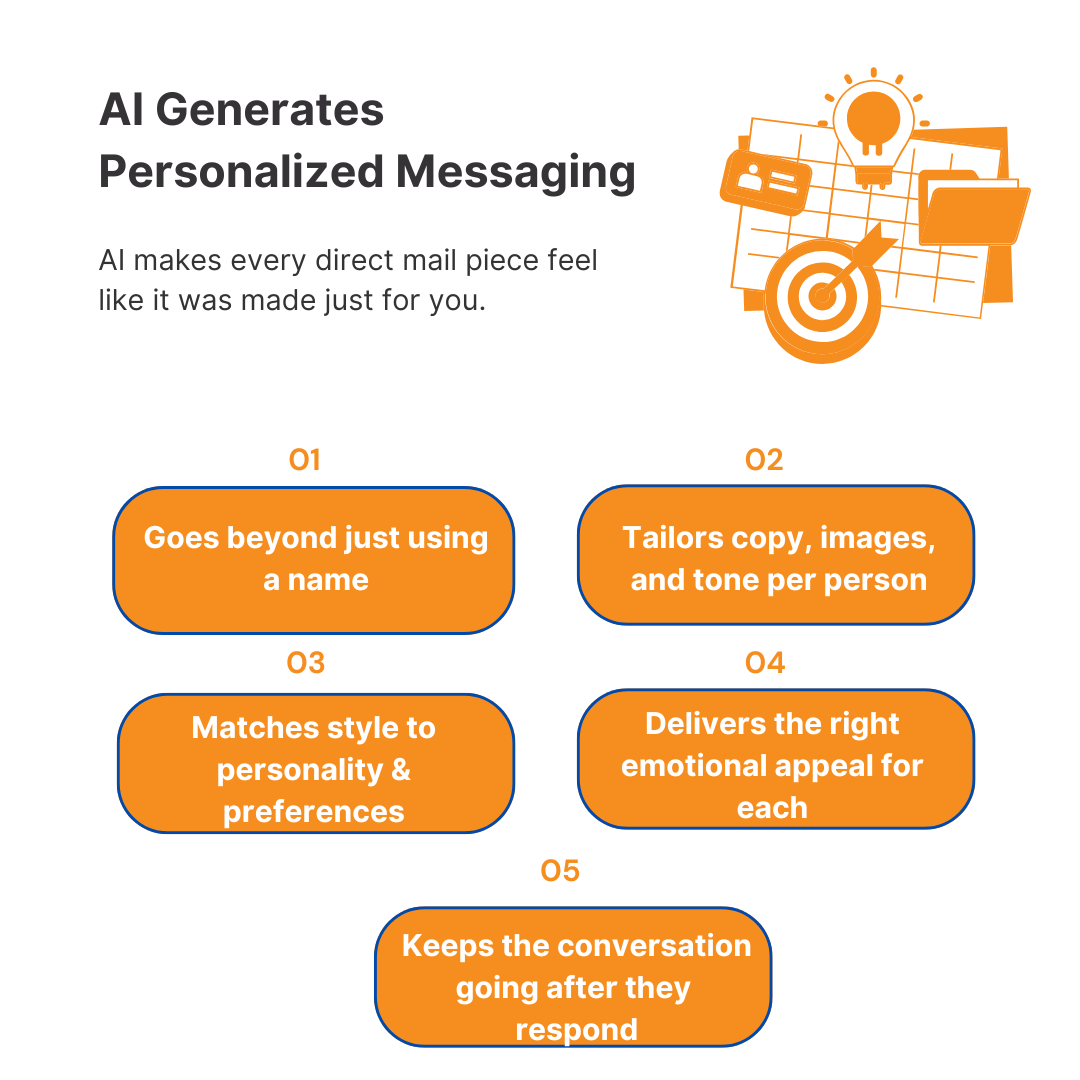
When people hear “personalized,” they usually think, Oh, you mean putting my name at the top? Yeah… AI is working on a whole different level. It pulls in every scrap of insight it has on a person and then uses it to create highly personalized messages that are unique to them.
Two people could get mail about the exact same product, but the way it is written, the images shown, the headline, and even the tone could be completely different. One person might get a bold, high-energy pitch with short sentences and bright visuals. Another might see a calmer, story-driven piece that leans into quality and craftsmanship.
And the use of AI in personalization is just the starting point. When the customer responds to your direct mail offer, AI can keep the conversation alive and moving toward a conversion.
To understand it better, let’s consider Rosie. Through its AI-integrated call services. Rosie answers calls 24/7, even after hours, with a natural, human-like tone that is trained on your product and offer.
Every call is handled in context, so if someone is responding to a specific direct mail promotion, AI can capture that information and ask qualifying questions you have set in advance. It can even route the lead to the right next step.
This way, AI makes it easy to connect offline responses from direct mail to your online sales process without adding more workload to your team.
6. Campaigns Are Continuously Refined Through Automated A/B Testing
Old-school A/B testing was slow. You would pick two versions, send them out, wait weeks, and then maybe learn something for next time. AI isn’t that patient.
With automated A/B testing, the system is running dozens of micro-tests in the background the moment your campaign starts – all without you sitting there swapping things manually.
The second it sees one version pulling ahead, it shifts the rest of your active campaign toward the winning version right away. That means people who haven’t gotten your mail yet are already going to get the stronger, more effective version before the ink on the first batch has even dried.
7. Delivery Routes & Timelines Are Optimized Using AI Logistics
Once your mail is printed, it still has a journey to make, and that journey can be full of delays and inefficiencies.
AI handles the boring-but-critical logistics side and figures out the fastest, most reliable way to get each piece from printer to mailbox. It can pull in data from postal services and outside factors like weather forecasts or known bottlenecks in certain regions.
If that means rerouting through a different sorting facility or adjusting the mailing sequence so certain regions get priority, it will make the call. The result is more mail landing when it is supposed to and fewer “Where is my package?” complaints.
8. Post-Campaign Analytics Use AI To Attribute ROI & Guide Next Steps
Once it is all over, AI can analyze campaign performance and piece things together between someone receiving your mail and them taking action, even if that action happens weeks later. It can separate the people who bought because of your campaign from those who would have bought anyway.
And you can use it for identifying patterns, like a certain product unexpectedly driving a spike in repeat purchases.
This isn’t just about patting yourself on the back for a good ROI. It is about having a crystal-clear picture of what is working, so the next campaign is built on connected data that direct mail automation has already pieced together for you.
How To Use AI for Direct Mail Personalization: 6 Strategies Proven To 4X Your ROI
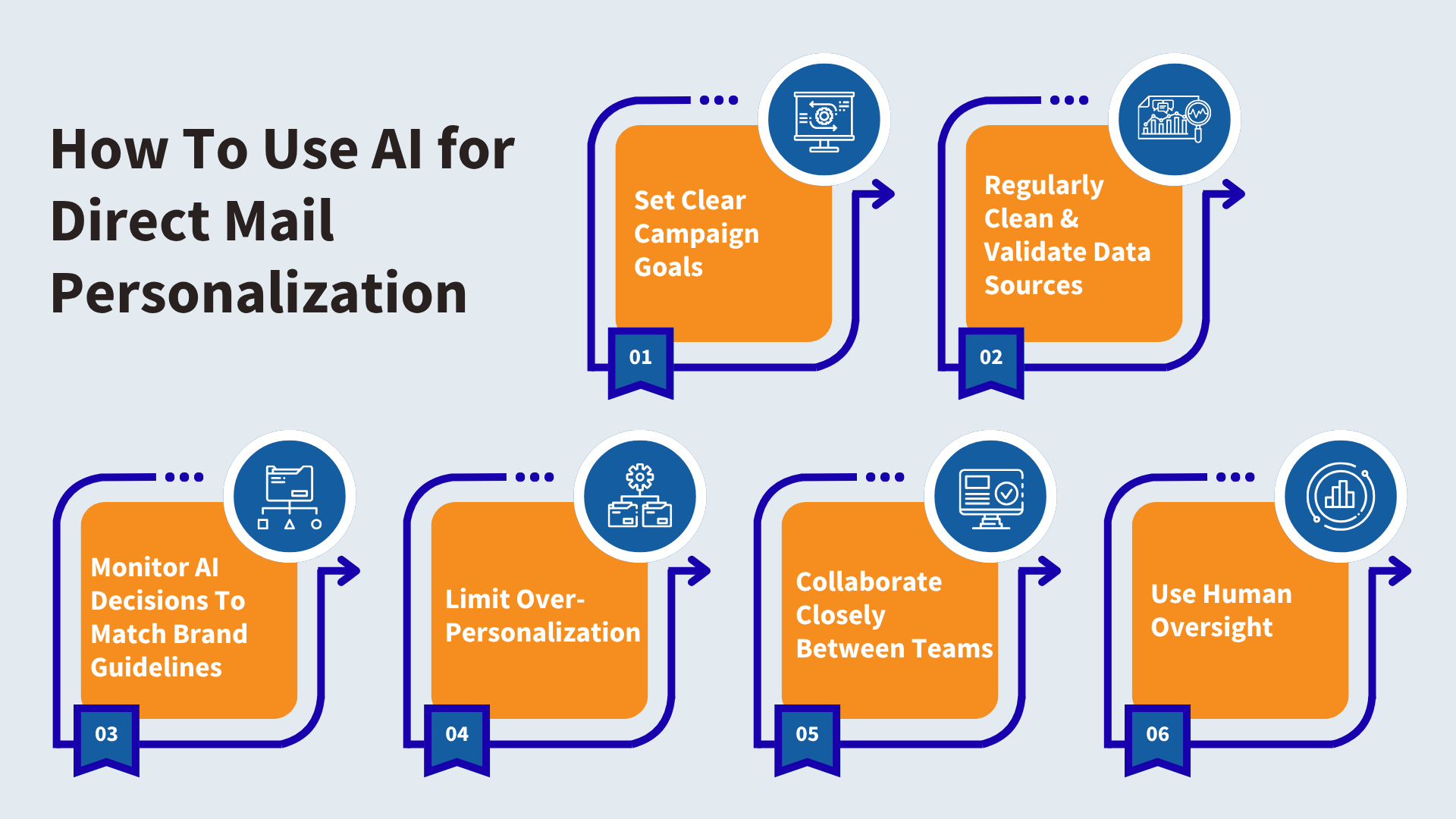
Here are 6 strategies to get the right mix of brains and brawn so your direct mail marketing campaign feels like it was written in the recipient’s head before it landed in their hands.
1. Set Clear Campaign Goals To Shape AI Optimization From The Start
AI is powerful, but it is not a mind reader. If you don’t tell it the purpose, it will just optimize based on whatever it assumes is important, and that can be completely different from what you actually want. Are you aiming for sales? Repeat purchases? Store visits? Newsletter signups?
When you firm up your goals before launch, AI can train its models on the right patterns and avoid wasting resources chasing the wrong outcomes.
What to Do:
- Lock in the one outcome that matters most for this campaign – not three, not five, just one.
- Put an actual number on it. “Better engagement” isn’t a goal; “30% lift in store redemptions” is.
- Feed the AI past campaign data so it has a reference point for what is good vs. great.
- Make sure every tweak or test ties back to that goal.
- Revisit the goal mid-campaign process to confirm it is still the right target.
2. Regularly Clean & Validate Data Sources Before Feeding Into AI Models
AI can’t magically turn bad data into good results. If the data you are giving it is outdated or full of holes, your “personalization” will feel off, sometimes embarrassingly off.
And cleaning data isn’t just deleting duplicates once in a while. It is making sure addresses are correct, names are spelled right, and you are not mailing to people who haven’t engaged with you in years. The cleaner the data, the sharper the AI’s decisions.
What to Do:
- Schedule data cleanups quarterly – fixed and non-negotiable.
- Scrub out dead addresses, unsubscribes, and serial non-responders.
- Run addresses through a validation tool before printing a single label.
- Standardize how your fields are named and formatted so the AI doesn’t choke on it.
- Keep a log of every cleaning cycle so you know when and what was done.
While it is important for all industries, it becomes even more critical for high-consideration investments. To put it in perspective, let’s consider the example of Nordvik’s outdoor saunas. These aren’t impulse purchases you pick up on a random afternoon.
That means your audience pool is smaller and the buying cycle is longer. One wrong name, outdated address, or irrelevant offer, and you have just burned a lead that took months (or even years) to warm up.
For this kind of product, you can’t afford to have AI crunching through messy, outdated data. If your records say someone is still at an address they moved away from two years ago, or that they are still in the market when they already bought elsewhere, your personalization efforts will actively erode trust.
3. Monitor AI Decisions To Ensure They Align With Brand Guidelines
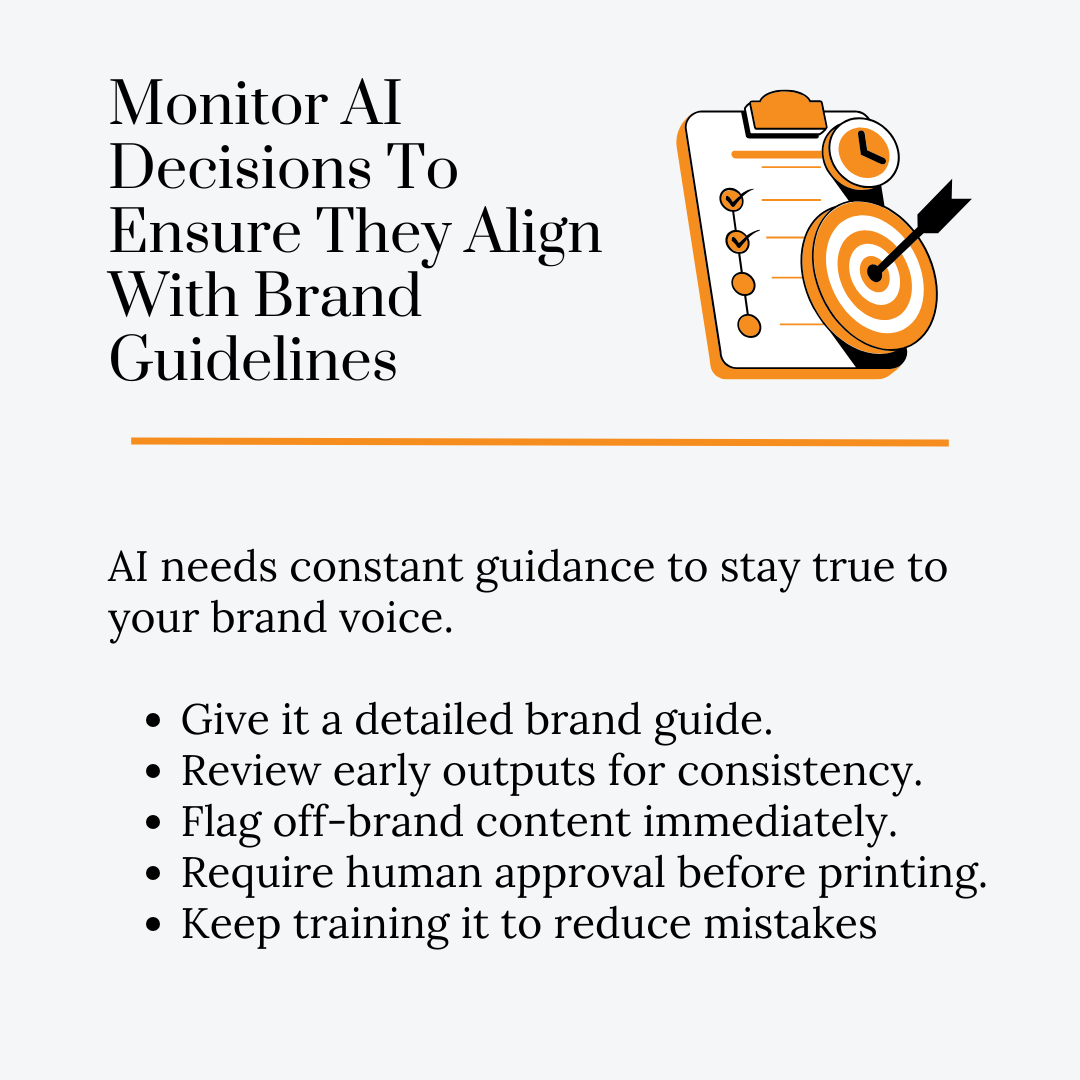
AI can be clever… and also completely miss the direction you want. Left unchecked, it might write something that technically “works” but makes your brand sound like a stranger at its own table.
You don’t want that. You want the AI to learn your brand’s pacing and style so it feels consistent no matter what it spits out. That only happens if you watch what it is doing and push it back on track when it drifts.
What to Do:
- Give the AI a brand bible – tone, words you love, words you ban, style rules, all of it.
- Skim early outputs before anything goes live so you can spot weirdness fast.
- Flag anything that sounds wrong so the AI’s feedback loop can course-correct.
- Lock in a human approval step before mass printing – always.
- Train it over time so those off-brand moments happen less and less.
Keeping AI on-brand is a constant watch with a lot of micro-decisions. That kind of vigilance takes time you probably don’t have when you are already stuck planning campaigns and approving creatives.
You need someone who notices the subtle things you might miss. The best solution is to bring in a virtual assistant who is experienced in AI workflows and data management.
Contrary to popular perception, a virtual assistant in this setup isn’t just “extra help.” They are the human layer that AI can’t replace. They remember the tiny details AI tends to forget, like a seasonal nuance or a cultural cue, and make sure those land exactly how you want.
And because they are embedded in the process, they quietly keep the whole thing on track – campaigns go out sharper and more in sync with your brand’s actual voice.
4. Limit Over-Personalization To Avoid Creeping Out Recipients
Yes, AI can know an insane amount about your customers. But just because you can use all that customer information doesn’t mean you should.
The goal is for people to feel seen, not stalked. Overdo it, and they will be wondering why you know so much about their Tuesday night browsing habits. Keep personalization to what feels natural and relevant, and they will stay engaged instead of suspicious.
What to Do:
- Personalize around broad customer preferences, not intimate details.
- Don’t reference actions they never directly shared with you.
- Test different levels of hyper-personalization to find the sweet spot.
- Lead with relevance, not with proof of how much you know.
- Ensure data privacy compliance and always make opting out simple and clear.
Some industries can get away with more personalization than others. In fashion retail, for example, customers expect a certain level of tailored recommendations. But for niche, tool-driven industries, the line between helpful and “too much” is razor thin.
This sewing machine parts business is a great example. A customer might browse replacement bobbins or motor belts for a specific model, but that doesn’t mean a direct mail piece should open with, “We noticed you viewed the replacement hook race for your Singer 201 on Wednesday afternoon.”
Instead, their direct mail could group preferences into broader categories – “parts to keep your vintage Singer running smoothly” or “most-requested upgrades for home quilting” – and show a curated selection that matches that interest.
The smart move for a brand like this is to make the personalization feel industry-savvy, not invasive. For example, rather than referencing the exact presser foot or bobbin case someone viewed, they could send a mailer featuring “5 most-used Singer accessories for garment construction” or “replacement parts every vintage Singer owner should keep on hand.”
This way, the content is still highly relevant but leaves enough breathing room so it doesn’t feel like you have been peering over their shoulder.
5. Collaborate Closely Between Data, Creative, & Marketing Teams
AI can be the most advanced tool in the room, but it still works best when the humans around it are actually talking to each other.
The data team might know the target audience inside out. The creative team knows how to make that audience feel something. The marketing team knows the timing and the bigger campaign goals. If those three groups don’t sync up, AI ends up getting pulled in different directions, and your personalization will feel disjointed.
What to Do:
- Hold joint planning sessions so every team understands the campaign’s personalization goals.
- Share AI insights with creatives in plain language instead of raw data tables.
- Let direct mail marketers guide priorities so AI recommendations stay aligned with campaign timing and channels.
- Keep feedback channels open – if AI results feel off, all three teams should review together.
- Document what worked in past collaborations so each project gets smoother.
While collaboration is a no-brainer for every industry, there are some niches where it is the difference between making a sale and losing a customer.
For example, in the workout supplements space, the audience is chasing specific performance goals – muscle growth, faster recovery, endurance, or fat loss. If you send a generic message, you signal that you don’t get their discipline or routine.
To understand it better, consider Transparent Labs. Their lineup includes pre-workouts, proteins, amino acids, and more, each catering to a specific fitness outcome.
Their data team could flag customers who just purchased protein powder but haven’t tried a pre-workout. Creative could then develop a mailer headlined “Fuel the Set Before the Shake,” with visuals showing the synergy between the two products. Marketing would schedule this drop to hit during a common “training recommitment” window, like the post-holiday gym rush.
When those three groups collaborate instead of working in silos, AI becomes the muscle behind direct mailing campaigns that feel like they were made for that athlete’s exact training phase.
6. Use Human Oversight To Spot Irrelevant Or Biased AI Recommendations
AI doesn’t always understand context. It might spot a correlation that is technically correct but completely useless, or worse, base recommendations on biased data without realizing it. Left unchecked, that can lead to personalization that is tone-deaf or even alienating.
Human oversight is your safeguard. A person can look at an AI-generated offer or message and immediately see if it is off-base or insensitive. That gut check is something AI can’t do, because it doesn’t know your audience’s lived reality – it only knows the numbers.
What to Do:
- Review AI recommendations for cultural fit, tone, and audience appropriateness before approval.
- Watch for patterns that suggest bias, like favoring certain demographics disproportionately.
- Gut-check whether the personalization actually adds value for the recipient or just feels forced.
- Have a small panel (marketing + creative + customer-facing roles) sign off on final AI-driven assets.
- Feed corrections back into the AI system so it can identify the most promising prospects.
Conclusion
When you use AI for direct mail personalization, you stop gambling on who might bite and start sending the exact thing, to the exact person, at the exact time they will care. So, let the AI pull the strings and stop your mail from being the stack they never open. This way, it becomes the one piece they actually act on. And that is where the money lives.
And when you are ready to do it, do it with Catdi Printing. We have the tech that makes it personal and the print quality that makes it impossible to ignore. This way, you can send out mail that feels like it was made for one person at a time, even if you are sending it to thousands. That is the formula that gets your mail opened, read, and acted on – exactly how you planned it.
Get your free quote and start transforming direct mail campaigns.








